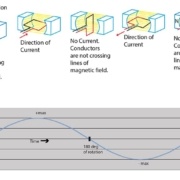Alternating Current and Direct Current
In your house, your wall outlets deliver alternating current (AC) electricity. The electricity provided to your house and your marina from the national electric grid is AC. Most of the devices in your house consume AC power.
In contrast, on a sailboat (and in your car), most of the electricity consumed by the devices on board is direct current (DC) and comes from the onboard battery.
There is a distinct difference between AC and DC electricity, and there is a very good reason why your house and your sailboat differ in this respect.
DC
While anchored up at night in a gorgeous cove, your only source of electricity (without the noise of an engine-powered generator) is from the batteries on board. Thus, batteries are an essential element of a modern-day yacht. Batteries power essentials such as lights, GPS devices, alarms, bilge pumps, and creature comforts like refrigerators, fans, and electric toilets. Some might also argue that the frozen concoction blender is also essential.
Batteries only store electric energy in the form of differently charged plates, one positively charged and the other negatively charged. When these plates are connected via a circuit (through a light bulb for example), electrons flow consistently in one direction from the negative plates out around the circuit and back to the positive plates. This unidirectional flow of electricity out from a battery is called direct current (DC). Thus, almost all of the devices needing electricity on a boat are designed to consume DC electricity because DC is readily available from the batteries. To charge a battery, which means to place positive and negative charges on opposing plates inside a battery, you must push DC current back into the battery.
AC
Some sailboats are fitted with air conditioning units and microwaves. By their own nature, they require AC electricity and a lot of it.
There are two sources of AC on a sailboat:
- While you are docked at the marina you can pull AC electricity from the marina via your shore power cord—the “yellow dock line.” This is called shore power because it comes from the shore. In the USA and Canada, the AC voltage is a potentially lethal 110 v AC. In most of the rest of the world, the AC voltage is an even more lethal 240 v AC.
- Your boat might have an onboard marine generator. These are large fuel-driven engines specifically designed to create enough electricity to power an air conditioning unit, microwave, and hair dryer, for example, while you are away from the marina. They weigh in the range of 500 pounds (230 kilograms) and are typically only on larger yachts greater than 40 feet (12 meters). Generators will typically also power the onboard AC outlets.
Creating electricity is fairly simple: You spin a shaft carrying copper wires between two magnets. As the wires cut through the magnetic field lines, electrical current is created in a direction through the wire. When the shaft rotates 180 degrees and cuts the magnetic field in the other direction, the current is reversed. This is the same process used in hydroelectric power stations, where the mechanical energy of the spinning shaft in a turbine is converted to electrical energy and distributed to the electric grid in AC form.
Creating Electricity
AC, by its own nature, is dynamic, and thus, it is not possible to store electrical energy in AC form in a static battery. So, you will never see a thing called an AC battery. To store electrical energy, you must convert AC to DC and then pump it into a battery.








